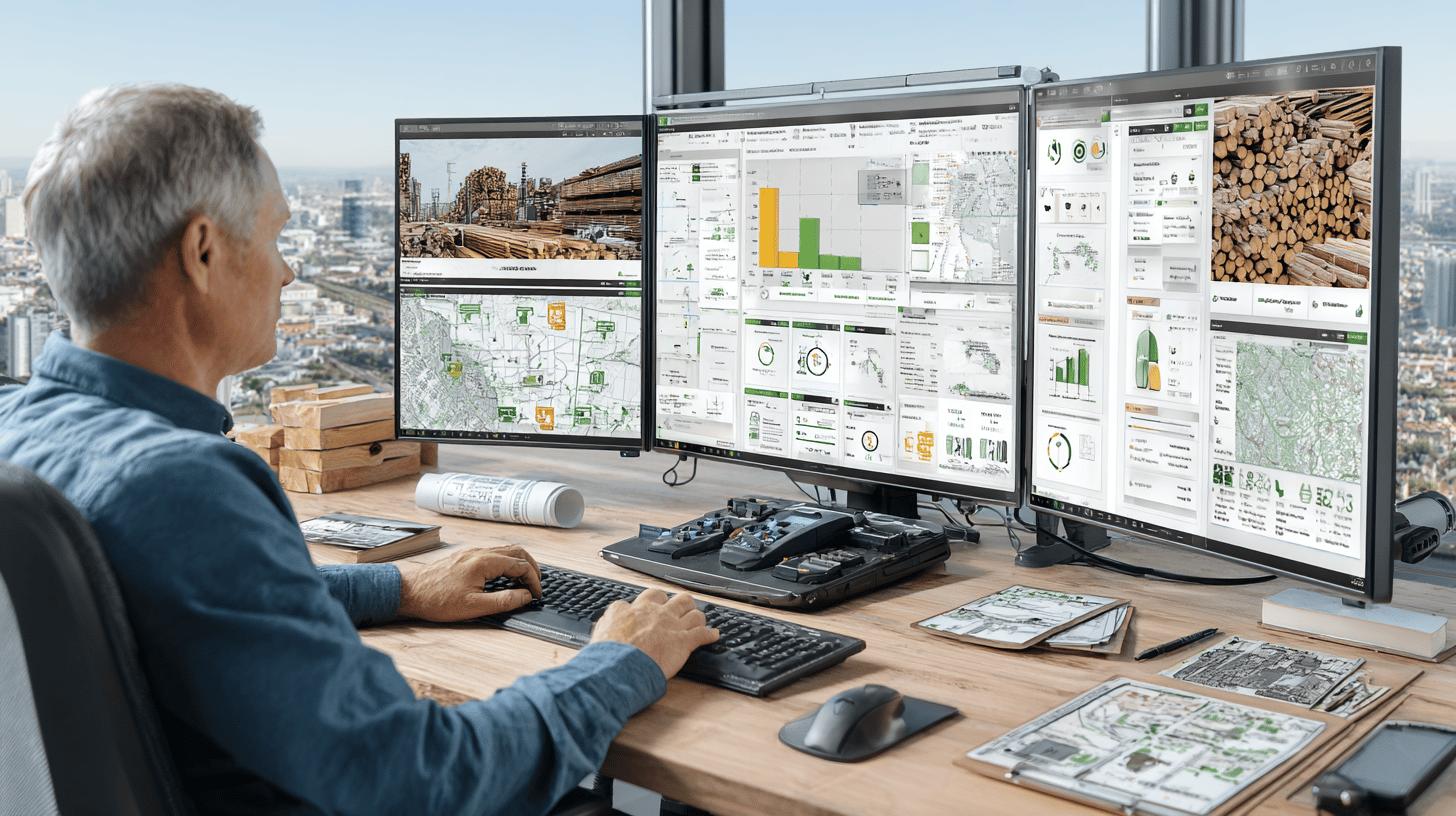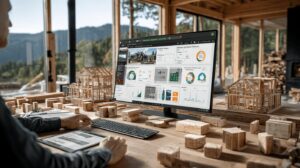Summary (TL;DR)
- Manufacturing teams can now analyze the full carbon footprint of construction timber across every project – without expert-only tools or consultant costs.
- Ecochain’s LCA automation software makes timber footprint measurement and compliance accessible to business users, helping you deliver reliable results and meet market demands for low-emission building.
- This guide explains how to break down timber’s environmental impact step-by-step, compare it against steel and concrete, and build your compliance strategy using practical, business-friendly tools.
What goes into the carbon footprint of timber and how to measure it?
Timber does something concrete can’t: it stores carbon.
Every cubic meter locks in about 0.9 tonnes of CO₂ as the tree grows – giving timber a natural head start over conventional materials.
But how do you measure that impact without needing to be a sustainability expert?
The construction timber carbon footprint breaks down into three parts:
- Sequestration: Trees absorb carbon as they grow, locking it within the wood fibers. That CO₂ stays locked inside when timber is used in construction – sometimes for decades.
- Embodied carbon: This is the total greenhouse gas emissions from raw material extraction, processing, transport, and manufacturing. Timber’s embodied carbon is up to 75% lower than steel or concrete because wood production requires less energy and emits fewer pollutants.
- Operational carbon: Once installed, operational carbon covers emissions arising from energy use, maintenance, and repair throughout a building’s lifespan. Timber’s thermal performance can also reduce operational energy needs.
If you want to measure timber’s true impact, it might be worth considering doing a life cycle assessment (LCA). LCA tracks every stage – raw material extraction, processing, transport, construction, use, and end-of-life – capturing both emissions and removals for accurate eco impact reporting.
A typical LCA for construction timber includes:
- Raw material extraction and harvesting (including forest management)
- Processing and manufacturing (sawmilling, panel production)
- Transportation (forest to mill, mill to site)
- Construction and installation (assembly, on-site impacts)
- Use, maintenance, and end-of-life (reuse, recycling, disposal)
| LCA stage | Timber emissions example | Steel/concrete emissions example |
|---|---|---|
| Raw material extraction | ~12 kg CO₂/m³ (net negative after sequestration) | ~350–500 kg CO₂/m³ |
| Processing/manufacturing | Low, uses renewable energy | High, energy-intensive |
| Transport | ~17–38 kg CO₂/m³ (depending on distance) | Similar or higher, heavier materials increase emissions |
| End-of-life | Potential for reuse, recycling, or carbon-stable disposal | Typically landfill or energy-intensive recycling |
LCA gives you a clear picture of timber’s real footprint – across every stage.
It’s how product teams, sustainability managers and procurement leads back up claims with facts.
How timber LCA works – step by step guide
You don’t need to be an LCA expert to assess timber’s environmental impact. With the right digital LCA tools, product and manufacturing teams can calculate emissions at every life cycle stage – and back it up with data.
Timber LCAs follow a standard structure – from forest to factory to reuse or disposal.
At each step, you measure emissions and carbon removals to get a complete picture.
- Raw material extraction (A1): Here you calculate emissions from forestry operations. For timber, this stage emits about 12 kg CO₂ per cubic meter, and that’s before factoring in carbon stored in the wood.
- Transportation (A2): Then, assess the impact of moving logs from forest to sawmill and beyond. This transport usually adds around 17 kg CO₂/m³. If you’re shipping overseas, that can rise to 38 kg CO₂/m³.
- Manufacturing (A3): Here you quantify energy used in sawmilling, panel production, and other processes. Timber tends to emit less here than steel or concrete – especially when mills run on renewable energy.
- Construction and use: Then you’ll also need to track emissions from on-site assembly, maintenance and repairs during the building’s lifetime.
- End-of-life: And finally, you measure emissions or removals depending on whether timber is reused, recycled or burned – key for circularity and long-term impact.
Comparing timber’s carbon footprint to other building materials like steel and concrete

As mentioned earlier, timber stores carbon.
One cubic meter of timber can store around 0.9 tonnes of CO₂. That turns parts of a building into long-term carbon sinks.
Steel and concrete, on the other hand, release large amounts of CO₂ during production – mostly due to fossil energy use. Producing a cubic meter of concrete emits around 300 kg of CO₂. For steel, it’s more than 1 tonne.
That’s why mass timber is emerging as the most practical low-carbon option for large-scale structures today – especially where carbon targets are strict.
So, how much carbon do timber, steel and concrete store or emit? Here’s a quick comparison:
| Material | CO₂ stored/emitted | Embodied carbon reduction | Typical use |
|---|---|---|---|
| Timber | Stores up to 0.9 t CO₂/m³ | Up to 75% lower than steel/concrete | Structural frames, panels, cladding |
| Steel | Emits 1.8–2.0 t CO₂/m³ | Baseline | Beams, columns, reinforcements |
| Concrete | Emits 0.25–0.35 t CO₂/m³ | Baseline | Floors, walls, foundations |
| Mass Timber | Stores up to 0.9 t CO₂/m³ | Up to 75% lower than steel/concrete | Large-scale structural systems |
Note: Mass timber stores similar amounts of CO₂ as regular timber, but is used in larger structural applications.
Choosing structural timber helps cut construction emissions – without compromising on strength or scale. For teams aiming to meet carbon targets, both solid and mass timber offer a measurable way to reduce embodied carbon and stay on track with regulations.
Regulations and certifications: what you need to manage timber’s carbon footprint
Regulations are catching up to timber’s climate potential.
Since 2021, the International Building Code allows mass timber buildings up to 18 storeys – a major shift that makes low-carbon design more accessible, while meeting strict compliance criteria.
But with that opportunity comes responsibility. To stay compliant, construction projects must prove two things:
-
That timber is responsibly sourced
-
That its carbon footprint is backed by data
That’s where certifications come in. Standards like PEFC, FSC, and national schemes (like Grown in Britain) confirm sustainable forestry practices – a requirement for including stored (biogenic) carbon in your carbon reporting.
To meet regulations and support claims, you’ll also need:
-
A whole life carbon assessment (LCA) that covers every stage – from forest to demolition
Together, these documents support carbon accounting, enable use of certified materials, and help teams hit compliance goals with confidence.
The challenge: Turning timber’s carbon potential into real EPD and LCA results
The carbon case for timber is strong. It’s renewable. It locks in CO₂. And it’s increasingly recognized in regulations, certifications and tenders.
But when you’re the one tasked with proving that carbon advantage? That’s where it gets messy.
You’re not just running numbers. You’re chasing down data that doesn’t always exist – or doesn’t arrive in a format you can actually use.
Here’s what slows teams down:
- Where did the timber come from? Is it certified? Locally grown? Harvested with biodiversity safeguards in place? These aren’t just nice-to-know details. They shape your LCA results.
- Can you trace emissions from forest to factory? Or are you piecing together supplier spreadsheets that don’t quite match your model?
- What about mass timber? Fire safety treatments, acoustic layers, structural reinforcements – they all add material flows and impact your carbon profile. But good luck finding standardized data for them.
- And then there’s the reporting layer. Are your assessments aligned with EN 15804? Do they meet national carbon requirements? Will they hold up in a tender review?
The truth is, none of these challenges is impossible to solve. But they exist, they’re interconnected, and they take time to untangle. What makes them hard isn’t the science – it’s the tracing, the verification, the alignment across systems.
That’s the real challenge: translating timber’s carbon potential into traceable, verifiable, defensible data.
Best practices: How to run a credible LCA for timber
You can’t control every data gap. But you can control how you prepare – and that makes all the difference when deadlines hit.
- Start with your scope: Don’t try to model everything at once. Define what you’re measuring: cradle-to-gate? Cradle-to-grave? Which life cycle stages matter for your building or product? The clearer your boundaries, the faster you’ll move. And the easier it is to explain your results later.
- Know your timber before you model it: Which forests? What certifications? How was it harvested? Timber isn’t one material – it’s sawn wood, glulam, CLT, treatments, adhesives, finishes. Each one brings its own supply chain. If you can’t answer these questions, your numbers may not hold up. Talk to your procurement team early. Get specifics. Document everything.
- Build a cross-functional team, even if it’s small: You’ll need input from procurement, operations, marketing, and sometimes R&D. Get them involved early, especially when you’re defining scope and assumptions. They’ll catch blind spots you’d miss alone, and they’ll feel ownership of the final number. Plus, when leadership asks tough questions, you’ve got people who understand the full picture backing you up.
- Map your supply chain end to end: You need to see the full journey: extraction, transport, processing, packaging, distribution. Not all of this data will be perfect, but it needs to be traceable. Work with suppliers to get actual emissions data where you can. If you’re working with a local sawmill or a supplier with EPDs, use their numbers. If you’re pulling from background datasets like Ecoinvent or NMD for standard components (steel fasteners, transport), that’s fine – just flag those assumptions clearly. The key is knowing which data points swing your results and which ones are stable enough to use generic values. This transparency builds credibility. It shows you’ve done your homework and aren’t hiding the gaps.
- Choose your framework and stick with it: EN 15804+A2? Product Environmental Footprint (PEF)? ISO 21930 or ISO 14025? National standards? Pick the one that matters most for your market and your stakeholders, then build your methodology around it. Consistency matters more than chasing every possible standard. You can always expand later, but starting fragmented just creates confusion.
- Document your assumptions like your credibility depends on it – because it does: What emission factors are you using? How are you handling biogenic carbon? What’s your allocation method for co-products? These are the questions that will come up – from clients, certifiers, procurement teams who don’t trust numbers they didn’t generate themselves. Track your sources. Note your assumptions. Keep a log of what you changed and why. If someone asks “where did this number come from?” six months later, you should be able to answer in under five minutes.
- Align with reporting requirements upfront: Is this for DGNB? BREEAM? A public tender? Each framework has its own expectations for system boundaries, impact categories and data quality. Don’t wait until the final review to realize your LCA doesn’t match the format they need. Check the requirements before you start modeling.
- Test your sensitivity: What happens if that local supplier falls through and you source from further away? What if you swap CLT for glulam? Run a few scenarios. See where your results shift. You’ll spot your vulnerabilities – and you’ll have answers ready when stakeholders ask “what if?”
- Get third-party verification: If this LCA is feeding into an EPD, going into a public tender, a sustainability report, or a product or marketing claim, consider having it checked by someone external. It costs time and money, but it’s the fastest way to build trust with stakeholders who are rightfully skeptical.
How Ecochain LCA software supports timber companies – and the teams behind them
If you’re sourcing, producing or using construction timber, you know carbon data isn’t optional anymore. It’s needed for tenders, EPDs, sustainability claims – and soon, full digital product passports.
Ecochain helps you get there. We’ve worked with timber manufacturers, prefab suppliers and engineered wood companies who need clear, verified data to:
-
Back claims with numbers
-
Reduce risk during verification
-
Support customers in carbon-critical projects
Whether you’re a sustainability manager needing reliable LCA data fast, or a product specialist juggling specs and emissions, our platform helps you measure, model and improve with confidence:
-
We supports LCA at scale – across multiple products, sites or materials
-
We give you fast insight for early design or product comparisons
-
Our professional services support you with onboarding, data prep and verification
Even without deep LCA expertise, you can build credible carbon reduction into your timber business – and show the impact with confidence.
Interested to see how Ecochain works in practice? Send us a message and one of our experts will get in touch with you shortly.
FAQs
What is mass timber, and why does it matter for carbon reduction?
Mass timber uses engineered wood products – like cross-laminated timber (CLT) and glulam – to create structural frames for buildings. It’s strong, lightweight and can replace steel or concrete in large-scale construction. The carbon advantage? Mass timber can cut embodied emissions by up to 75% compared to conventional materials, while storing CO₂ for decades.
How does timber store carbon?
Trees absorb CO₂ as they grow, locking it into the wood. When that timber is used in construction, the carbon stays locked inside – sometimes for 50+ years. Each cubic meter stores around 0.9 tonnes of CO₂. That turns parts of a building into long-term carbon sinks.
What’s the difference between embodied carbon and operational carbon for timber?
Embodied carbon is the emissions from producing and transporting materials before they’re installed. Operational carbon is the energy used during a building’s lifetime – heating, cooling, maintenance. Timber’s embodied carbon is up to 75% lower than steel or concrete, and its thermal properties can reduce operational energy needs too.
How do you measure timber’s carbon footprint?
You can measure timber’s carbon footprint through Life Cycle Assessment (LCA) using an intuitive, LCA automation software like Ecochain. LCA tracks emissions across every stage: raw material extraction, processing, transport, construction, use and end-of-life. It captures both emissions and carbon removals, giving you a complete picture. Standards like EN 15804 and ISO 21930 guide how timber LCAs are structured and reported.
Can LCA software help with timber carbon assessments?
Yes, LCA software like Ecochain automates the data collection, modeling and reporting process – making it accessible to anyone in your company, not just sustainability experts. Ecochain lets you model timber products at scale, compare scenarios, generate EPDs and align with standards like EN 15804. You don’t need deep LCA expertise to run credible assessments or meet compliance requirements.
What regulations apply to mass timber construction?
Since 2021, the International Building Code allows mass timber buildings up to 18 storeys. To comply, projects must prove responsible sourcing (via certifications) and provide verified carbon data (via LCAs and EPDs). Requirements vary by region, but the trend is toward stricter carbon reporting and whole-life assessments.




